Performance Management and Motivation in Kiwi Furniture: HRM Report
VerifiedAdded on 2023/04/24
|28
|6358
|391
Report
AI Summary
This report provides a comprehensive analysis of Kiwi Furniture's Human Resource Management (HRM) practices, focusing on motivation and performance management. It examines the application of motivational theories such as Expectancy Theory and Equity Theory within the context of Kiwi Furniture's internationalization strategy, specifically considering its operations in New Zealand, China, and Germany. The report evaluates the effectiveness of Kiwi Furniture's performance management system, identifying shortcomings and proposing improvements using various approaches like comparative and behavioral approaches. Furthermore, it offers three key recommendations, including the implementation of a 360-degree feedback system, to enhance the company's HRM practices and overall organizational performance. The report is based on the provided case study and incorporates relevant HRM theories and concepts to address the challenges faced by Kiwi Furniture.

HRM 1
Human Resource Management
Human Resource Management
Paraphrase This Document
Need a fresh take? Get an instant paraphrase of this document with our AI Paraphraser
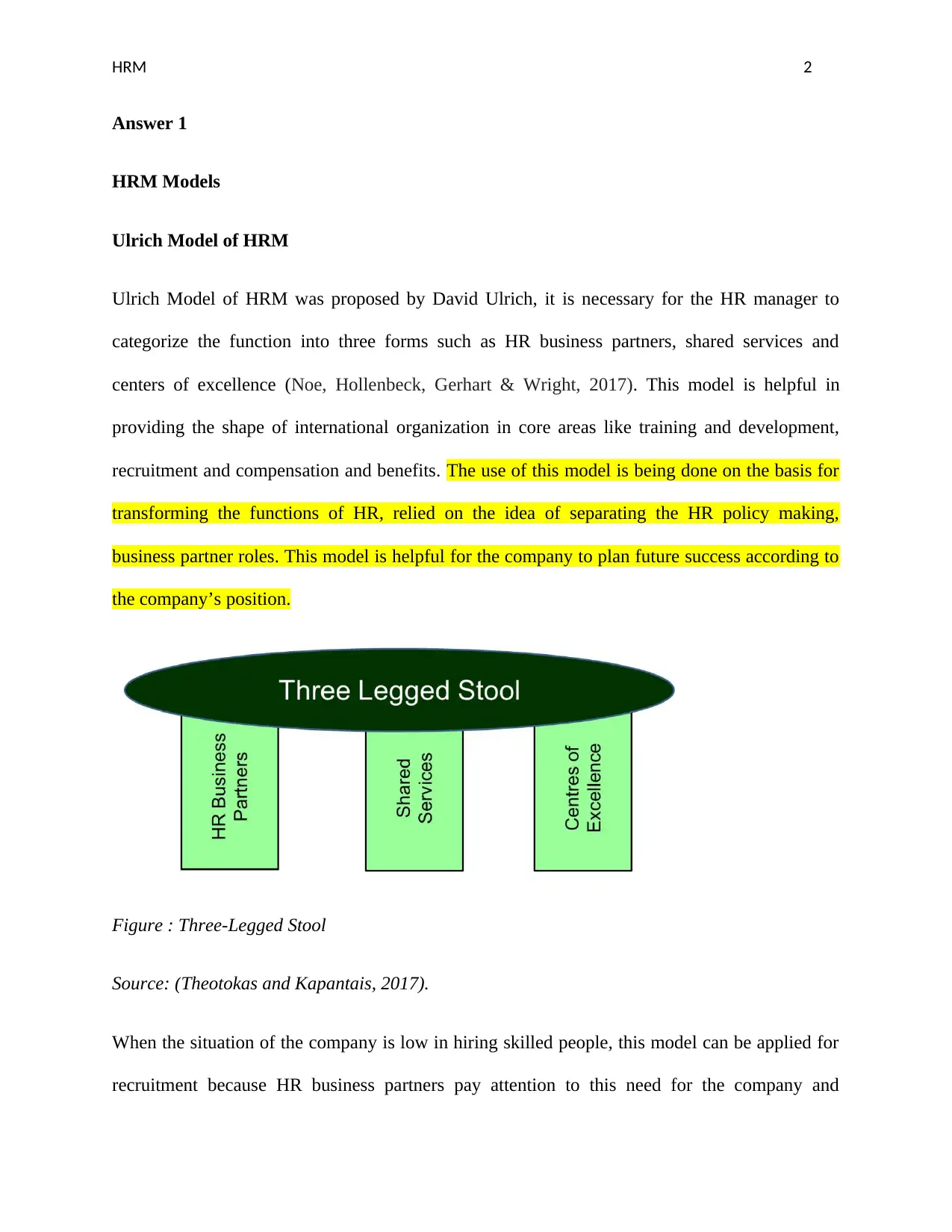
HRM 2
Answer 1
HRM Models
Ulrich Model of HRM
Ulrich Model of HRM was proposed by David Ulrich, it is necessary for the HR manager to
categorize the function into three forms such as HR business partners, shared services and
centers of excellence (Noe, Hollenbeck, Gerhart & Wright, 2017). This model is helpful in
providing the shape of international organization in core areas like training and development,
recruitment and compensation and benefits. The use of this model is being done on the basis for
transforming the functions of HR, relied on the idea of separating the HR policy making,
business partner roles. This model is helpful for the company to plan future success according to
the company’s position.
Figure : Three-Legged Stool
Source: (Theotokas and Kapantais, 2017).
When the situation of the company is low in hiring skilled people, this model can be applied for
recruitment because HR business partners pay attention to this need for the company and
Answer 1
HRM Models
Ulrich Model of HRM
Ulrich Model of HRM was proposed by David Ulrich, it is necessary for the HR manager to
categorize the function into three forms such as HR business partners, shared services and
centers of excellence (Noe, Hollenbeck, Gerhart & Wright, 2017). This model is helpful in
providing the shape of international organization in core areas like training and development,
recruitment and compensation and benefits. The use of this model is being done on the basis for
transforming the functions of HR, relied on the idea of separating the HR policy making,
business partner roles. This model is helpful for the company to plan future success according to
the company’s position.
Figure : Three-Legged Stool
Source: (Theotokas and Kapantais, 2017).
When the situation of the company is low in hiring skilled people, this model can be applied for
recruitment because HR business partners pay attention to this need for the company and
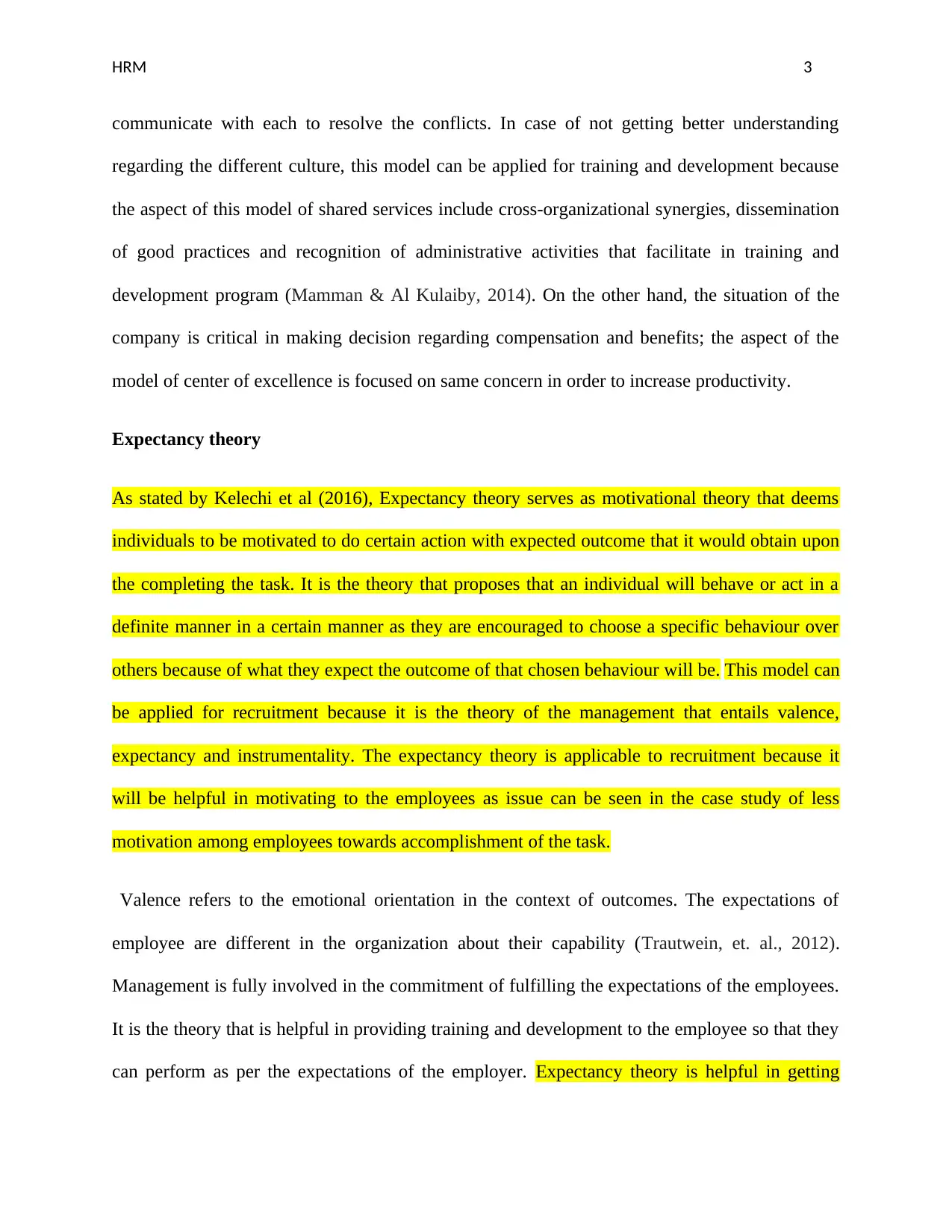
HRM 3
communicate with each to resolve the conflicts. In case of not getting better understanding
regarding the different culture, this model can be applied for training and development because
the aspect of this model of shared services include cross-organizational synergies, dissemination
of good practices and recognition of administrative activities that facilitate in training and
development program (Mamman & Al Kulaiby, 2014). On the other hand, the situation of the
company is critical in making decision regarding compensation and benefits; the aspect of the
model of center of excellence is focused on same concern in order to increase productivity.
Expectancy theory
As stated by Kelechi et al (2016), Expectancy theory serves as motivational theory that deems
individuals to be motivated to do certain action with expected outcome that it would obtain upon
the completing the task. It is the theory that proposes that an individual will behave or act in a
definite manner in a certain manner as they are encouraged to choose a specific behaviour over
others because of what they expect the outcome of that chosen behaviour will be. This model can
be applied for recruitment because it is the theory of the management that entails valence,
expectancy and instrumentality. The expectancy theory is applicable to recruitment because it
will be helpful in motivating to the employees as issue can be seen in the case study of less
motivation among employees towards accomplishment of the task.
Valence refers to the emotional orientation in the context of outcomes. The expectations of
employee are different in the organization about their capability (Trautwein, et. al., 2012).
Management is fully involved in the commitment of fulfilling the expectations of the employees.
It is the theory that is helpful in providing training and development to the employee so that they
can perform as per the expectations of the employer. Expectancy theory is helpful in getting
communicate with each to resolve the conflicts. In case of not getting better understanding
regarding the different culture, this model can be applied for training and development because
the aspect of this model of shared services include cross-organizational synergies, dissemination
of good practices and recognition of administrative activities that facilitate in training and
development program (Mamman & Al Kulaiby, 2014). On the other hand, the situation of the
company is critical in making decision regarding compensation and benefits; the aspect of the
model of center of excellence is focused on same concern in order to increase productivity.
Expectancy theory
As stated by Kelechi et al (2016), Expectancy theory serves as motivational theory that deems
individuals to be motivated to do certain action with expected outcome that it would obtain upon
the completing the task. It is the theory that proposes that an individual will behave or act in a
definite manner in a certain manner as they are encouraged to choose a specific behaviour over
others because of what they expect the outcome of that chosen behaviour will be. This model can
be applied for recruitment because it is the theory of the management that entails valence,
expectancy and instrumentality. The expectancy theory is applicable to recruitment because it
will be helpful in motivating to the employees as issue can be seen in the case study of less
motivation among employees towards accomplishment of the task.
Valence refers to the emotional orientation in the context of outcomes. The expectations of
employee are different in the organization about their capability (Trautwein, et. al., 2012).
Management is fully involved in the commitment of fulfilling the expectations of the employees.
It is the theory that is helpful in providing training and development to the employee so that they
can perform as per the expectations of the employer. Expectancy theory is helpful in getting
⊘ This is a preview!⊘
Do you want full access?
Subscribe today to unlock all pages.

Trusted by 1+ million students worldwide
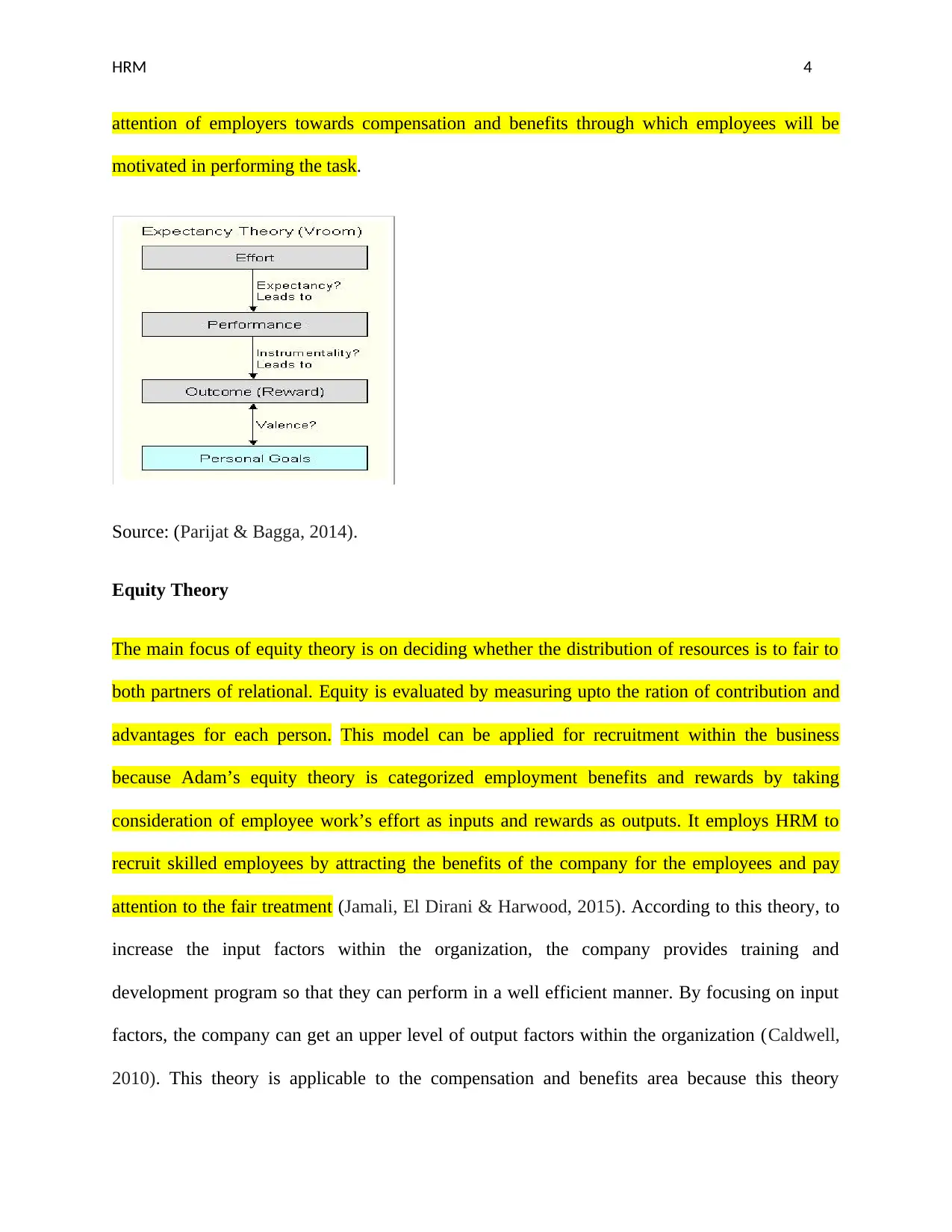
HRM 4
attention of employers towards compensation and benefits through which employees will be
motivated in performing the task.
Source: (Parijat & Bagga, 2014).
Equity Theory
The main focus of equity theory is on deciding whether the distribution of resources is to fair to
both partners of relational. Equity is evaluated by measuring upto the ration of contribution and
advantages for each person. This model can be applied for recruitment within the business
because Adam’s equity theory is categorized employment benefits and rewards by taking
consideration of employee work’s effort as inputs and rewards as outputs. It employs HRM to
recruit skilled employees by attracting the benefits of the company for the employees and pay
attention to the fair treatment (Jamali, El Dirani & Harwood, 2015). According to this theory, to
increase the input factors within the organization, the company provides training and
development program so that they can perform in a well efficient manner. By focusing on input
factors, the company can get an upper level of output factors within the organization (Caldwell,
2010). This theory is applicable to the compensation and benefits area because this theory
attention of employers towards compensation and benefits through which employees will be
motivated in performing the task.
Source: (Parijat & Bagga, 2014).
Equity Theory
The main focus of equity theory is on deciding whether the distribution of resources is to fair to
both partners of relational. Equity is evaluated by measuring upto the ration of contribution and
advantages for each person. This model can be applied for recruitment within the business
because Adam’s equity theory is categorized employment benefits and rewards by taking
consideration of employee work’s effort as inputs and rewards as outputs. It employs HRM to
recruit skilled employees by attracting the benefits of the company for the employees and pay
attention to the fair treatment (Jamali, El Dirani & Harwood, 2015). According to this theory, to
increase the input factors within the organization, the company provides training and
development program so that they can perform in a well efficient manner. By focusing on input
factors, the company can get an upper level of output factors within the organization (Caldwell,
2010). This theory is applicable to the compensation and benefits area because this theory
Paraphrase This Document
Need a fresh take? Get an instant paraphrase of this document with our AI Paraphraser
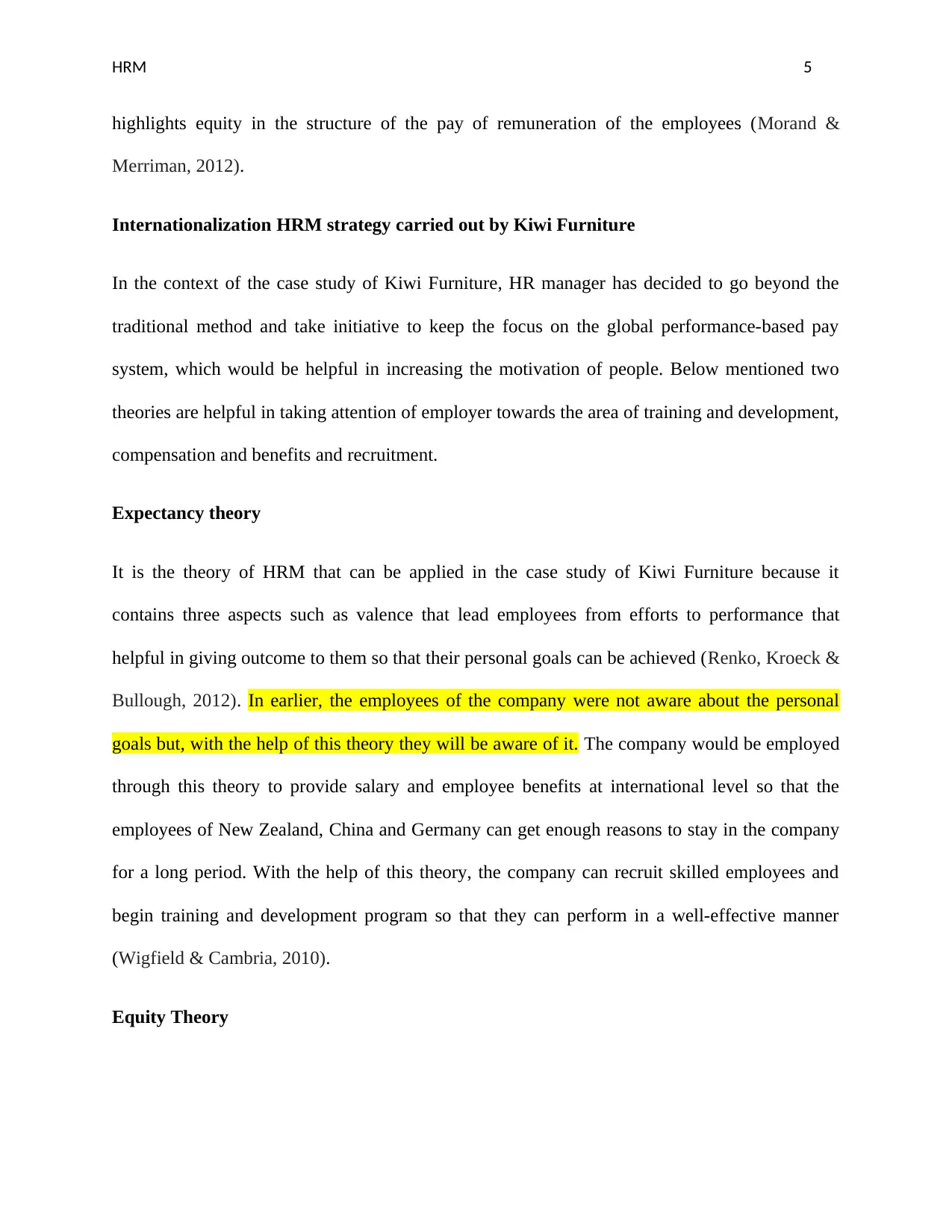
HRM 5
highlights equity in the structure of the pay of remuneration of the employees (Morand &
Merriman, 2012).
Internationalization HRM strategy carried out by Kiwi Furniture
In the context of the case study of Kiwi Furniture, HR manager has decided to go beyond the
traditional method and take initiative to keep the focus on the global performance-based pay
system, which would be helpful in increasing the motivation of people. Below mentioned two
theories are helpful in taking attention of employer towards the area of training and development,
compensation and benefits and recruitment.
Expectancy theory
It is the theory of HRM that can be applied in the case study of Kiwi Furniture because it
contains three aspects such as valence that lead employees from efforts to performance that
helpful in giving outcome to them so that their personal goals can be achieved (Renko, Kroeck &
Bullough, 2012). In earlier, the employees of the company were not aware about the personal
goals but, with the help of this theory they will be aware of it. The company would be employed
through this theory to provide salary and employee benefits at international level so that the
employees of New Zealand, China and Germany can get enough reasons to stay in the company
for a long period. With the help of this theory, the company can recruit skilled employees and
begin training and development program so that they can perform in a well-effective manner
(Wigfield & Cambria, 2010).
Equity Theory
highlights equity in the structure of the pay of remuneration of the employees (Morand &
Merriman, 2012).
Internationalization HRM strategy carried out by Kiwi Furniture
In the context of the case study of Kiwi Furniture, HR manager has decided to go beyond the
traditional method and take initiative to keep the focus on the global performance-based pay
system, which would be helpful in increasing the motivation of people. Below mentioned two
theories are helpful in taking attention of employer towards the area of training and development,
compensation and benefits and recruitment.
Expectancy theory
It is the theory of HRM that can be applied in the case study of Kiwi Furniture because it
contains three aspects such as valence that lead employees from efforts to performance that
helpful in giving outcome to them so that their personal goals can be achieved (Renko, Kroeck &
Bullough, 2012). In earlier, the employees of the company were not aware about the personal
goals but, with the help of this theory they will be aware of it. The company would be employed
through this theory to provide salary and employee benefits at international level so that the
employees of New Zealand, China and Germany can get enough reasons to stay in the company
for a long period. With the help of this theory, the company can recruit skilled employees and
begin training and development program so that they can perform in a well-effective manner
(Wigfield & Cambria, 2010).
Equity Theory
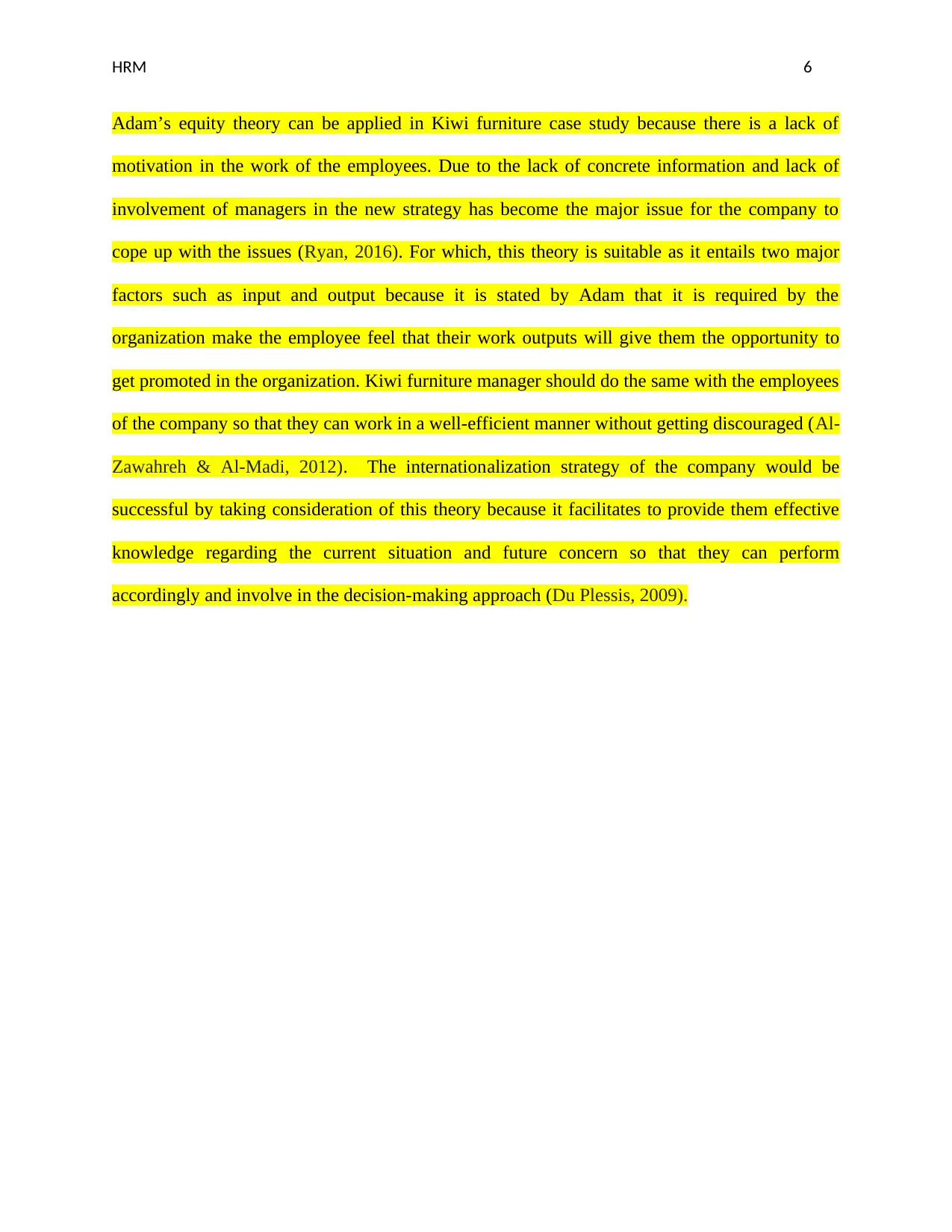
HRM 6
Adam’s equity theory can be applied in Kiwi furniture case study because there is a lack of
motivation in the work of the employees. Due to the lack of concrete information and lack of
involvement of managers in the new strategy has become the major issue for the company to
cope up with the issues (Ryan, 2016). For which, this theory is suitable as it entails two major
factors such as input and output because it is stated by Adam that it is required by the
organization make the employee feel that their work outputs will give them the opportunity to
get promoted in the organization. Kiwi furniture manager should do the same with the employees
of the company so that they can work in a well-efficient manner without getting discouraged (Al-
Zawahreh & Al-Madi, 2012). The internationalization strategy of the company would be
successful by taking consideration of this theory because it facilitates to provide them effective
knowledge regarding the current situation and future concern so that they can perform
accordingly and involve in the decision-making approach (Du Plessis, 2009).
Adam’s equity theory can be applied in Kiwi furniture case study because there is a lack of
motivation in the work of the employees. Due to the lack of concrete information and lack of
involvement of managers in the new strategy has become the major issue for the company to
cope up with the issues (Ryan, 2016). For which, this theory is suitable as it entails two major
factors such as input and output because it is stated by Adam that it is required by the
organization make the employee feel that their work outputs will give them the opportunity to
get promoted in the organization. Kiwi furniture manager should do the same with the employees
of the company so that they can work in a well-efficient manner without getting discouraged (Al-
Zawahreh & Al-Madi, 2012). The internationalization strategy of the company would be
successful by taking consideration of this theory because it facilitates to provide them effective
knowledge regarding the current situation and future concern so that they can perform
accordingly and involve in the decision-making approach (Du Plessis, 2009).
⊘ This is a preview!⊘
Do you want full access?
Subscribe today to unlock all pages.

Trusted by 1+ million students worldwide
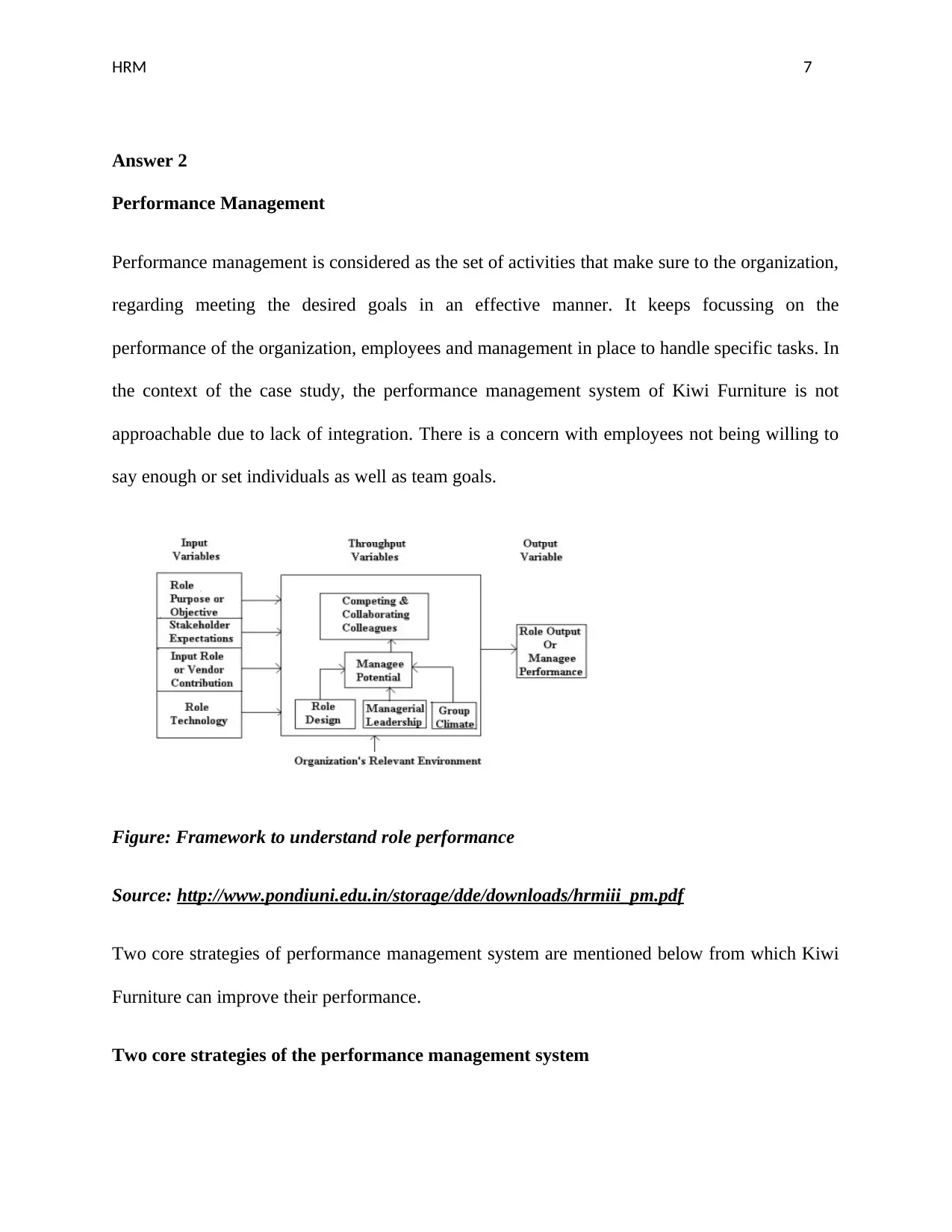
HRM 7
Answer 2
Performance Management
Performance management is considered as the set of activities that make sure to the organization,
regarding meeting the desired goals in an effective manner. It keeps focussing on the
performance of the organization, employees and management in place to handle specific tasks. In
the context of the case study, the performance management system of Kiwi Furniture is not
approachable due to lack of integration. There is a concern with employees not being willing to
say enough or set individuals as well as team goals.
Figure: Framework to understand role performance
Source: http://www.pondiuni.edu.in/storage/dde/downloads/hrmiii_pm.pdf
Two core strategies of performance management system are mentioned below from which Kiwi
Furniture can improve their performance.
Two core strategies of the performance management system
Answer 2
Performance Management
Performance management is considered as the set of activities that make sure to the organization,
regarding meeting the desired goals in an effective manner. It keeps focussing on the
performance of the organization, employees and management in place to handle specific tasks. In
the context of the case study, the performance management system of Kiwi Furniture is not
approachable due to lack of integration. There is a concern with employees not being willing to
say enough or set individuals as well as team goals.
Figure: Framework to understand role performance
Source: http://www.pondiuni.edu.in/storage/dde/downloads/hrmiii_pm.pdf
Two core strategies of performance management system are mentioned below from which Kiwi
Furniture can improve their performance.
Two core strategies of the performance management system
Paraphrase This Document
Need a fresh take? Get an instant paraphrase of this document with our AI Paraphraser
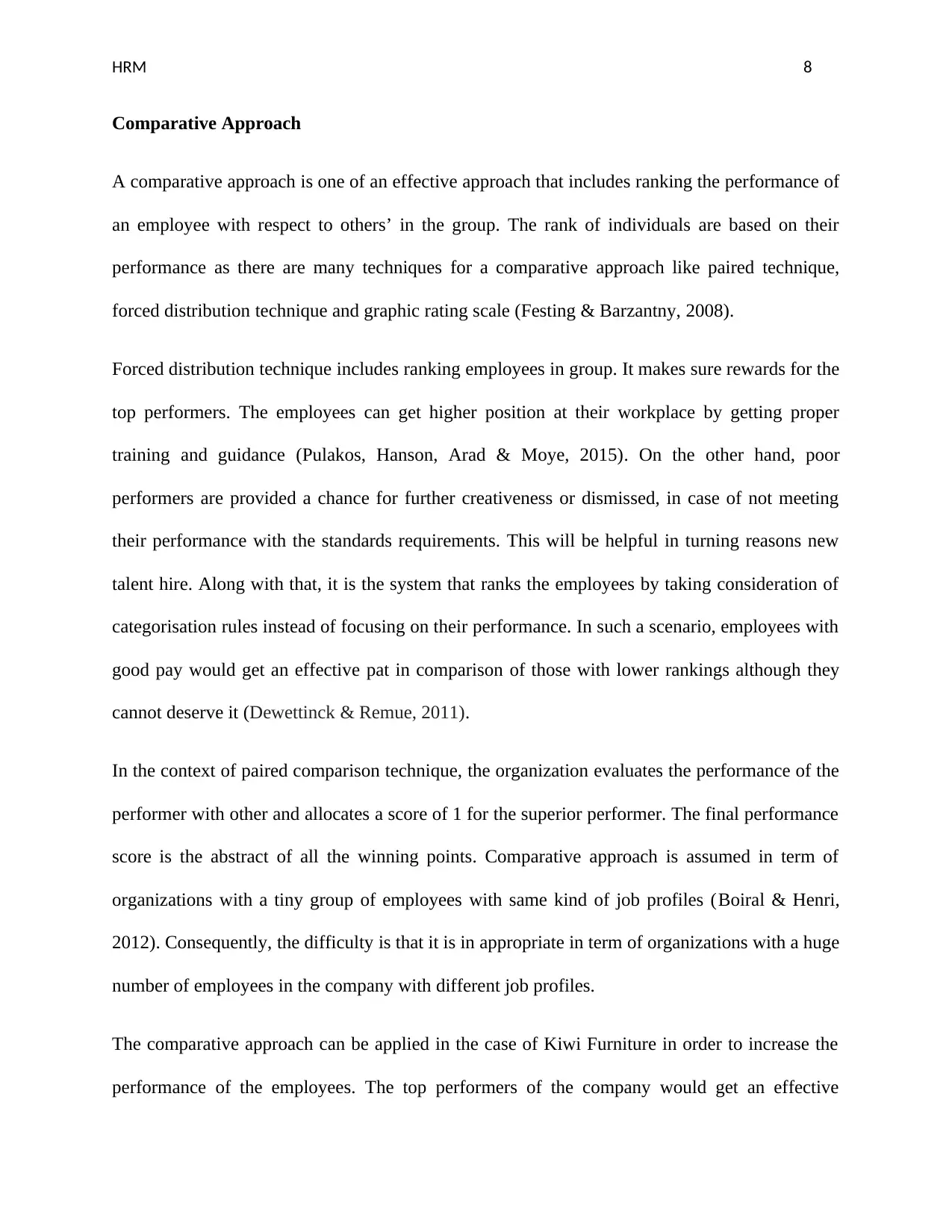
HRM 8
Comparative Approach
A comparative approach is one of an effective approach that includes ranking the performance of
an employee with respect to others’ in the group. The rank of individuals are based on their
performance as there are many techniques for a comparative approach like paired technique,
forced distribution technique and graphic rating scale (Festing & Barzantny, 2008).
Forced distribution technique includes ranking employees in group. It makes sure rewards for the
top performers. The employees can get higher position at their workplace by getting proper
training and guidance (Pulakos, Hanson, Arad & Moye, 2015). On the other hand, poor
performers are provided a chance for further creativeness or dismissed, in case of not meeting
their performance with the standards requirements. This will be helpful in turning reasons new
talent hire. Along with that, it is the system that ranks the employees by taking consideration of
categorisation rules instead of focusing on their performance. In such a scenario, employees with
good pay would get an effective pat in comparison of those with lower rankings although they
cannot deserve it (Dewettinck & Remue, 2011).
In the context of paired comparison technique, the organization evaluates the performance of the
performer with other and allocates a score of 1 for the superior performer. The final performance
score is the abstract of all the winning points. Comparative approach is assumed in term of
organizations with a tiny group of employees with same kind of job profiles (Boiral & Henri,
2012). Consequently, the difficulty is that it is in appropriate in term of organizations with a huge
number of employees in the company with different job profiles.
The comparative approach can be applied in the case of Kiwi Furniture in order to increase the
performance of the employees. The top performers of the company would get an effective
Comparative Approach
A comparative approach is one of an effective approach that includes ranking the performance of
an employee with respect to others’ in the group. The rank of individuals are based on their
performance as there are many techniques for a comparative approach like paired technique,
forced distribution technique and graphic rating scale (Festing & Barzantny, 2008).
Forced distribution technique includes ranking employees in group. It makes sure rewards for the
top performers. The employees can get higher position at their workplace by getting proper
training and guidance (Pulakos, Hanson, Arad & Moye, 2015). On the other hand, poor
performers are provided a chance for further creativeness or dismissed, in case of not meeting
their performance with the standards requirements. This will be helpful in turning reasons new
talent hire. Along with that, it is the system that ranks the employees by taking consideration of
categorisation rules instead of focusing on their performance. In such a scenario, employees with
good pay would get an effective pat in comparison of those with lower rankings although they
cannot deserve it (Dewettinck & Remue, 2011).
In the context of paired comparison technique, the organization evaluates the performance of the
performer with other and allocates a score of 1 for the superior performer. The final performance
score is the abstract of all the winning points. Comparative approach is assumed in term of
organizations with a tiny group of employees with same kind of job profiles (Boiral & Henri,
2012). Consequently, the difficulty is that it is in appropriate in term of organizations with a huge
number of employees in the company with different job profiles.
The comparative approach can be applied in the case of Kiwi Furniture in order to increase the
performance of the employees. The top performers of the company would get an effective

HRM 9
training program to learn more about the expansion of the business by providing good quality
services to the customer. This activity will motivate them to do work by keeping in mind the
tendency of common goal.
Behavioural Approach
Behavioural approach is one of the oldest performance measurement techniques. Vertical scales
of various dimensions of the job consist under behavioral approach. This can be done by using
BARS technique or BOS technique. The Behaviourally Anchored Rating Scale (BARS)
technique entails five to ten vertical scales. These scales rely on different parameters which are
determined consensually from all employees (Albrecht, et. al., 2015). As per this approach,
employees are allowed to rank on each of the anchors as per their performance.
Conversely, Behavioural Observation Scale (BOS) is a new version of BARS. It gives a more
precise elaboration along with occurrence in the context of employee behaviour for effective
performance. In general, the score is the standard of all these frequencies. The behavioural
approach is effective for the accuracy and reliability, the major disadvantage in this approach is
the huge data that the managers have to remind (Snape & Redman, 2010).
Behavioural approach of the performance management can be applied to the case study of Kiwi
Furniture because it is good enough in linking employee behaviour to company strategy. By this
approach, the HR manager of Kiwi Furniture can encourage employee to accomplish the task
with good behaviour. This approach automatically connects with performance with the
attainment of goals, conflict of interest, and reward (De Waal, 2013). Hence, it facilitates
management to make decisions and evaluate organizational goals so that employee satisfaction
can be increased due to proper performance appraisal.
training program to learn more about the expansion of the business by providing good quality
services to the customer. This activity will motivate them to do work by keeping in mind the
tendency of common goal.
Behavioural Approach
Behavioural approach is one of the oldest performance measurement techniques. Vertical scales
of various dimensions of the job consist under behavioral approach. This can be done by using
BARS technique or BOS technique. The Behaviourally Anchored Rating Scale (BARS)
technique entails five to ten vertical scales. These scales rely on different parameters which are
determined consensually from all employees (Albrecht, et. al., 2015). As per this approach,
employees are allowed to rank on each of the anchors as per their performance.
Conversely, Behavioural Observation Scale (BOS) is a new version of BARS. It gives a more
precise elaboration along with occurrence in the context of employee behaviour for effective
performance. In general, the score is the standard of all these frequencies. The behavioural
approach is effective for the accuracy and reliability, the major disadvantage in this approach is
the huge data that the managers have to remind (Snape & Redman, 2010).
Behavioural approach of the performance management can be applied to the case study of Kiwi
Furniture because it is good enough in linking employee behaviour to company strategy. By this
approach, the HR manager of Kiwi Furniture can encourage employee to accomplish the task
with good behaviour. This approach automatically connects with performance with the
attainment of goals, conflict of interest, and reward (De Waal, 2013). Hence, it facilitates
management to make decisions and evaluate organizational goals so that employee satisfaction
can be increased due to proper performance appraisal.
⊘ This is a preview!⊘
Do you want full access?
Subscribe today to unlock all pages.

Trusted by 1+ million students worldwide

HRM 10
Three recommendations to improve Kiwi Furniture
It has been analyzed through a case study that employees do not want to share a positive and
negative critique of them. The employees of the organization prefer old numerical performance
management scale where they are allowed to rate them as per their satisfaction level. From the
case study, it has come to know that there is a lack of concrete information and evaluation in the
implementation of performance management that being the main cause of disappointment of
Kiwi Managers and the managers think that the subsidiary staff is not making any efforts to
adopt new performance management strategies. There are three recommendations mentioned
below to improve Kiwi Furniture.
360-degree feedback
It is vital for the company to keep the focus on 360-degree appraisal in the company as it entails
many advantages that can increase the productivity of Kiwi Furniture. It is helpful in increasing
self-awareness, balanced view, leverage strengths, cover blind spots and development of skills
(Espinilla, de Andrés, Martínez & Martínez, 2013). It is the level to which the performance
management system extracts job performance that is consistent with the strategy and goals of the
organization (Bititci, Cocca & Ates, 2016). It is recommended to Kiwi Furniture’s HR Manager
to highlights the need for the performance management system to escort employees in keeping
efforts to achieve a common goal.
Balanced Score Card
The company should focus on balance score card in order to analyze the used resources in the
organization. It involves customer perspective, financial perspective and internal process
Three recommendations to improve Kiwi Furniture
It has been analyzed through a case study that employees do not want to share a positive and
negative critique of them. The employees of the organization prefer old numerical performance
management scale where they are allowed to rate them as per their satisfaction level. From the
case study, it has come to know that there is a lack of concrete information and evaluation in the
implementation of performance management that being the main cause of disappointment of
Kiwi Managers and the managers think that the subsidiary staff is not making any efforts to
adopt new performance management strategies. There are three recommendations mentioned
below to improve Kiwi Furniture.
360-degree feedback
It is vital for the company to keep the focus on 360-degree appraisal in the company as it entails
many advantages that can increase the productivity of Kiwi Furniture. It is helpful in increasing
self-awareness, balanced view, leverage strengths, cover blind spots and development of skills
(Espinilla, de Andrés, Martínez & Martínez, 2013). It is the level to which the performance
management system extracts job performance that is consistent with the strategy and goals of the
organization (Bititci, Cocca & Ates, 2016). It is recommended to Kiwi Furniture’s HR Manager
to highlights the need for the performance management system to escort employees in keeping
efforts to achieve a common goal.
Balanced Score Card
The company should focus on balance score card in order to analyze the used resources in the
organization. It involves customer perspective, financial perspective and internal process
Paraphrase This Document
Need a fresh take? Get an instant paraphrase of this document with our AI Paraphraser
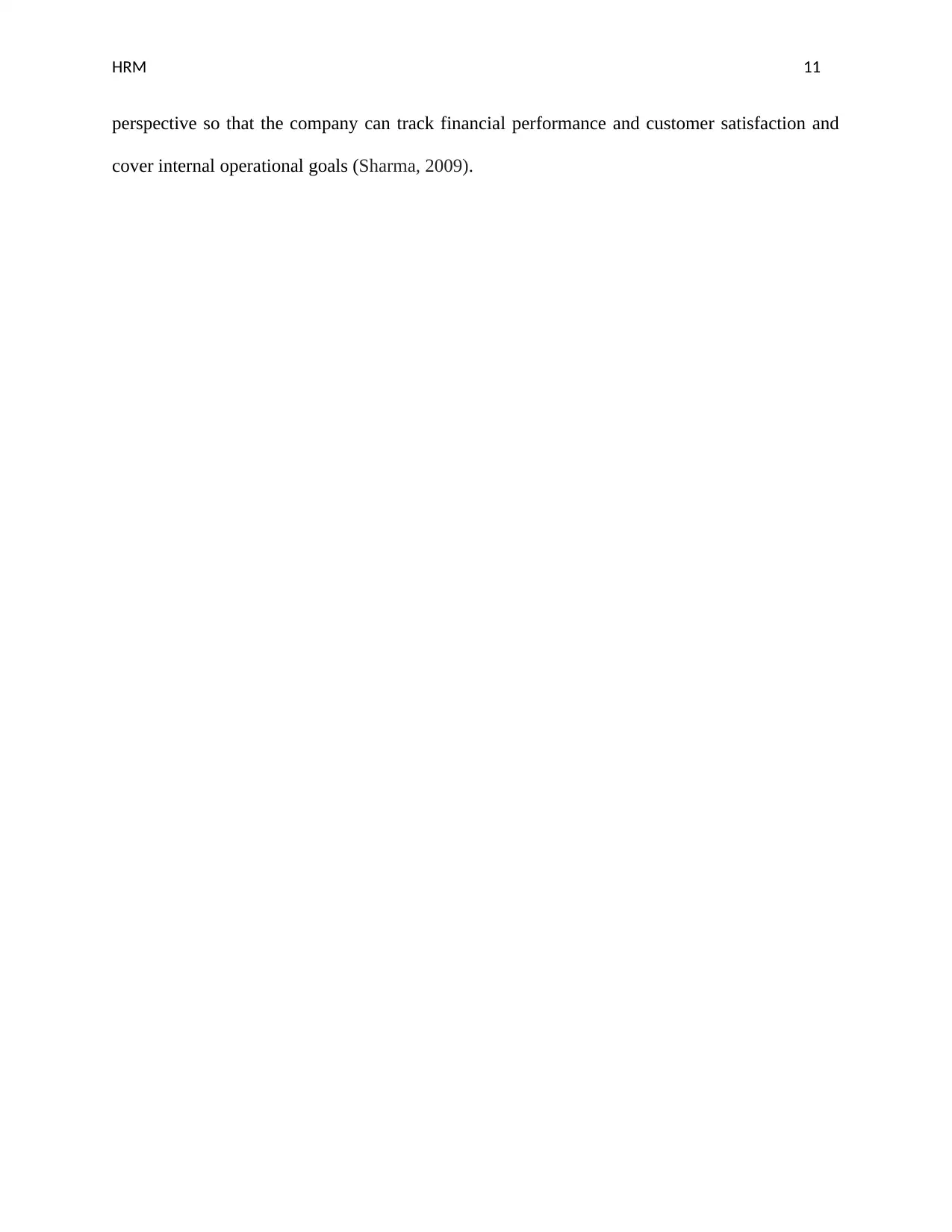
HRM 11
perspective so that the company can track financial performance and customer satisfaction and
cover internal operational goals (Sharma, 2009).
perspective so that the company can track financial performance and customer satisfaction and
cover internal operational goals (Sharma, 2009).
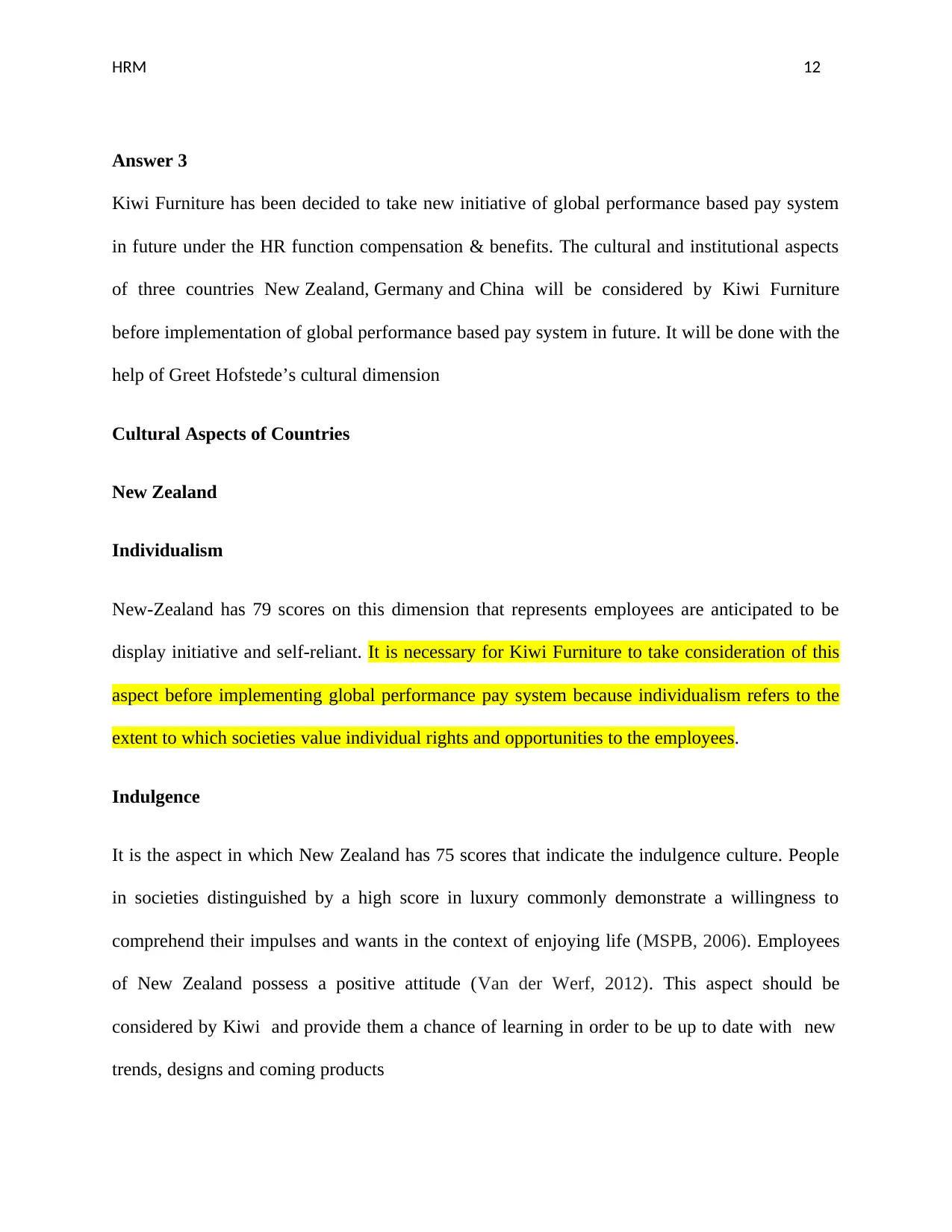
HRM 12
Answer 3
Kiwi Furniture has been decided to take new initiative of global performance based pay system
in future under the HR function compensation & benefits. The cultural and institutional aspects
of three countries New Zealand, Germany and China will be considered by Kiwi Furniture
before implementation of global performance based pay system in future. It will be done with the
help of Greet Hofstede’s cultural dimension
Cultural Aspects of Countries
New Zealand
Individualism
New-Zealand has 79 scores on this dimension that represents employees are anticipated to be
display initiative and self-reliant. It is necessary for Kiwi Furniture to take consideration of this
aspect before implementing global performance pay system because individualism refers to the
extent to which societies value individual rights and opportunities to the employees.
Indulgence
It is the aspect in which New Zealand has 75 scores that indicate the indulgence culture. People
in societies distinguished by a high score in luxury commonly demonstrate a willingness to
comprehend their impulses and wants in the context of enjoying life (MSPB, 2006). Employees
of New Zealand possess a positive attitude (Van der Werf, 2012). This aspect should be
considered by Kiwi and provide them a chance of learning in order to be up to date with new
trends, designs and coming products
Answer 3
Kiwi Furniture has been decided to take new initiative of global performance based pay system
in future under the HR function compensation & benefits. The cultural and institutional aspects
of three countries New Zealand, Germany and China will be considered by Kiwi Furniture
before implementation of global performance based pay system in future. It will be done with the
help of Greet Hofstede’s cultural dimension
Cultural Aspects of Countries
New Zealand
Individualism
New-Zealand has 79 scores on this dimension that represents employees are anticipated to be
display initiative and self-reliant. It is necessary for Kiwi Furniture to take consideration of this
aspect before implementing global performance pay system because individualism refers to the
extent to which societies value individual rights and opportunities to the employees.
Indulgence
It is the aspect in which New Zealand has 75 scores that indicate the indulgence culture. People
in societies distinguished by a high score in luxury commonly demonstrate a willingness to
comprehend their impulses and wants in the context of enjoying life (MSPB, 2006). Employees
of New Zealand possess a positive attitude (Van der Werf, 2012). This aspect should be
considered by Kiwi and provide them a chance of learning in order to be up to date with new
trends, designs and coming products
⊘ This is a preview!⊘
Do you want full access?
Subscribe today to unlock all pages.

Trusted by 1+ million students worldwide
1 out of 28
Related Documents
Your All-in-One AI-Powered Toolkit for Academic Success.
+13062052269
info@desklib.com
Available 24*7 on WhatsApp / Email
![[object Object]](/_next/static/media/star-bottom.7253800d.svg)
Unlock your academic potential
Copyright © 2020–2025 A2Z Services. All Rights Reserved. Developed and managed by ZUCOL.





